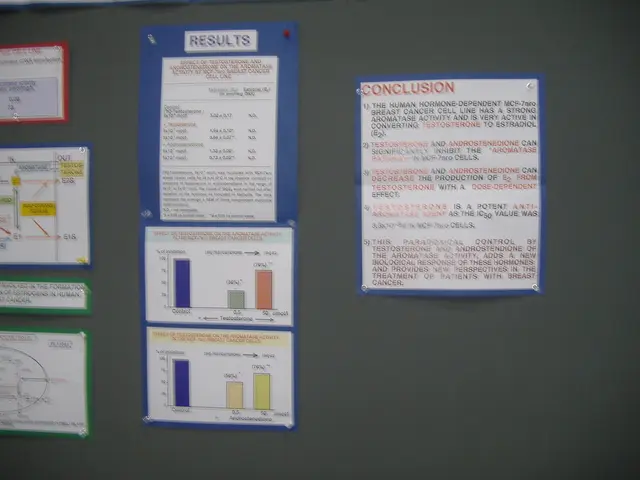Borrowing a fresh perspective on mortgage refinancing
Mortgage Refinancing Explained: Understanding the Process and Its Implications
Refinancing your home loan could be your ticket to a better deal or financial freedom, but it pays to understand what you're getting into.
What's the 4-1-1 on refinancing?
Refinancing is a strategy for exchanging your current mortgage for a new one, potentially altering the rate, term, or both. You can even switch lenders if the new deal appeals to you.
How does this refinancing jive work?
The process resembles the initial mortgage application, although it's a less intense version. Here's roughly how it goes:
- The lender checks your credit.
- You submit your financial documents.
- You order a home appraisal.
- Your loan goes through the underwriting process.
- Complete the process, on average, in 30 to 45 days.
Insight: Did you know that, on average, it takes 48 days to close a refinanced mortgage? That's according to ICE Mortgage Technology as of January 2025.
Types of refinancing to suit your situation like a glove
There are various types of refinancing, so consider which fits best with your unique financial profile. Your goals might be to chop your loan term in half or nab a lower monthly payment. Read on for the lowdown on each:
- Rate-and-Term Refinance: Changes your interest rate or loan term, or both.
- Cash-Out Refinance: Leverages your home equity to withdraw cash for personal expenses or projects.
- Cash-In Refinance: Pays down your loan balance, reducing debt and potentially fetching a lower interest rate or canceling private mortgage insurance.
- No-Closing-Cost Refinance: Skips upfront closing costs in favor of rolling them into your new loan, meaning a higher monthly payment and likely a higher interest rate.
- Short Refinance: Designed for homeowners at risk of foreclosure, lowering your new loan below the original balance and letting the lender forgive the difference.
- Reverse Mortgage: Available for homeowners aged 62 and up, allowing you to tap your home's equity and receive monthly payments from your lender.
- Debt Consolidation Refinance: Clears other non-mortgage debt, like credit card balances, using your home's equity.
- Streamline Refinance: A speedier process for eligible borrowers, eliminating some requirements such as a credit check or appraisal.
Insight: The smart choice comes down to your financial goals and the specifics of your home's equity and current mortgage.
Ready, set, refinance your mortgage
Once you've refinanced your home or rental property, the process is much like the regular mortgage application process. Clearly define your objectives, check your credit, and prepare yourself for the home appraisal.
Step 1: Set clear financial goals
There should be a solid reason behind your refinancing, like reducing your monthly payment or shortening your loan term.
Insight: If you reduce your interest rate but expand the loan period, the resulting lower monthly payment might save you every month, but it'll cost you more overall in interest.
Step 2: Check your credit score and history
You'll need to qualify for a refinance, just like with your original home loan. Higher credit scores mean savings on interest rates and improved odds of approval. For a conventional refinance, you'll need a credit score of 620 or greater.
Insight: A refinance can put a temporary dent in your credit score but is usually minimal. When refinancing, your credit report receives multiple inquiries from lenders, which can lower your score slightly. Shopping for rates within a 45-day window ensures only one inquiry counts against your credit score.
Step 3: Ascertain the equity in your property
Your home equity is your home's value minus what you owe on your mortgage. Check your latest mortgage statement for your balance and determine your home's value. The difference is your equity.
Insight: A higher equity stake in your home means a lower-risk loan for lenders, often resulting in better rates and fewer fees.
Step 4: Compare offers from multiple lenders
Seeking rate quotes from at least three mortgage lenders helps you maximize your savings. Discuss optimal times to lock in your rate to avoid rate spikes before closing.
Insight: Besides interest rates, pay attention to the various fees. Some lenders may offer no-closing-cost refinances but charge a higher interest rate to compensate.
Step 5: Gather your paperwork
Prepare your recent pay stubs, federal tax returns, bank statements, and any other documents your lender requests. Be candid about your assets, liabilities, and overall financial situation.
Step 6: Brace for the home appraisal
Lenders usually require a home appraisal, similar to when you bought your home, to estimate its market value.
Insight: You'll shell out a few hundred dollars for the appraisal. Let your lender or the appraiser know about recent improvements, additions, or major repairs. This helps them accurately assess your property and potentially secure a higher appraisal value.
Step 7: Bring cash to the closing, if needed
The closing disclosure and loan estimate outline closing costs, which can add up to a few thousand dollars.
Insight: Although you may finance the costs, it's usually financially wiser to pay them upfront if you're able.
Step 8: Monitor your loan closely
Some lenders offer incentives, like autopay discounts. Store your closing paperwork in a secure place.
Insight: Your lender or servicer may sell your loan to a different company, so keep an eye out for notifications about loan transfers.
Pros and cons of refinancing
Pros
- Lower interest rate
- Decreased monthly payment
- Shorter loan term and accelerated payoff
- Access to home equity
- Consolidation of debt into one streamlined payment
- Switching from adjustable-rate to fixed-rate mortgages
- Elimination of private mortgage insurance premiums
Cons
- Closing costs
- Prolonged loan term, increasing costs and delaying payoff
- Reduced equity if cash is withdrawn
- Borrower's remorse due to dropped interest rates after closing
- Time-consuming process (takes 15 to 45 days or more)
- Mild hit to credit score
- Potential increase in property taxes following home improvements
- Refinancing may not make sense if you've paid off a large portion of your mortgage
When to refinance your mortgage
Refinancing your mortgage is a significant decision that hinges on various factors, such as your financial goals and the mortgage market climate. If you plan to stay in your home for the long haul, extending your loan term might create more breathing room in your monthly budget or provide funds for home improvements.
Capturing the right moment to refinance can save you thousands. According to Jeff Ostrowski, principal writer at our website, if you took out a loan at 8% in 2023, this is an excellent time to refinance. Yet, for most homeowners, it's still too soon to jump on the refinancing bandwagon.
Insight: Mortgage refinance rates are beginning to dip from their post-pandemic highs, making it an appealing option for some homeowners.
Homeowner's guide to mortgage refinance FAQs
- How much do closing costs on a mortgage refinance amount to?Closing costs for a refinance typically range between 2% and 5% of the amount refinanced. These charges include discount points, the loan origination fee, and an appraisal fee.[1][3] To determine if refinancing makes sense, calculate the break-even point for these expenses and see if you'll stay in your home long enough to recoup the savings.
- What's the deal with a second mortgage compared to a refinance?A second mortgage is not the same as a refinance. Refinancing replaces your current mortgage with a new one, while a second mortgage is an additional loan based on the equity built in your home.[1] A second mortgage introduces another monthly payment with its own interest rate.
- How long must you wait before refinancing your mortgage?The time needed for refinancing depends on the loan type and the mortgage investor. For example, FHA loans require a six-month waiting period after the initial purchase or the previous refinance.[2] Besides time, another factor affecting refinancing is equity. Typically, you'll need at least 20% equity before refinancing to secure favorable terms.
[1] Mortgage Calculator by NerdWallet[2] FHA Loans by the U.S. Department of Housing and Urban Development[3] Consumer Financial Protection Bureau[4] Home Mortgages by Investopedia
- Refinancing your home equity through a new mortgage could potentially lower your monthly payments or interest rate, leading to financial freedom.
- The documentation required for refinancing includes credit reports, financial statements, tax returns, and a home appraisal, similar to the initial mortgage application process.
- Post-refinancing, personal finance management is crucial to ensure the monthly payments are budgeted for effectively and to monitor the loan closely for any changes or incentives.
- As the percentage of homeowners refinancing their mortgages is climbing, it's essential to understand the pros and cons, such as lower interest rates, decreased monthly payments, and closing costs, before making a decision.




